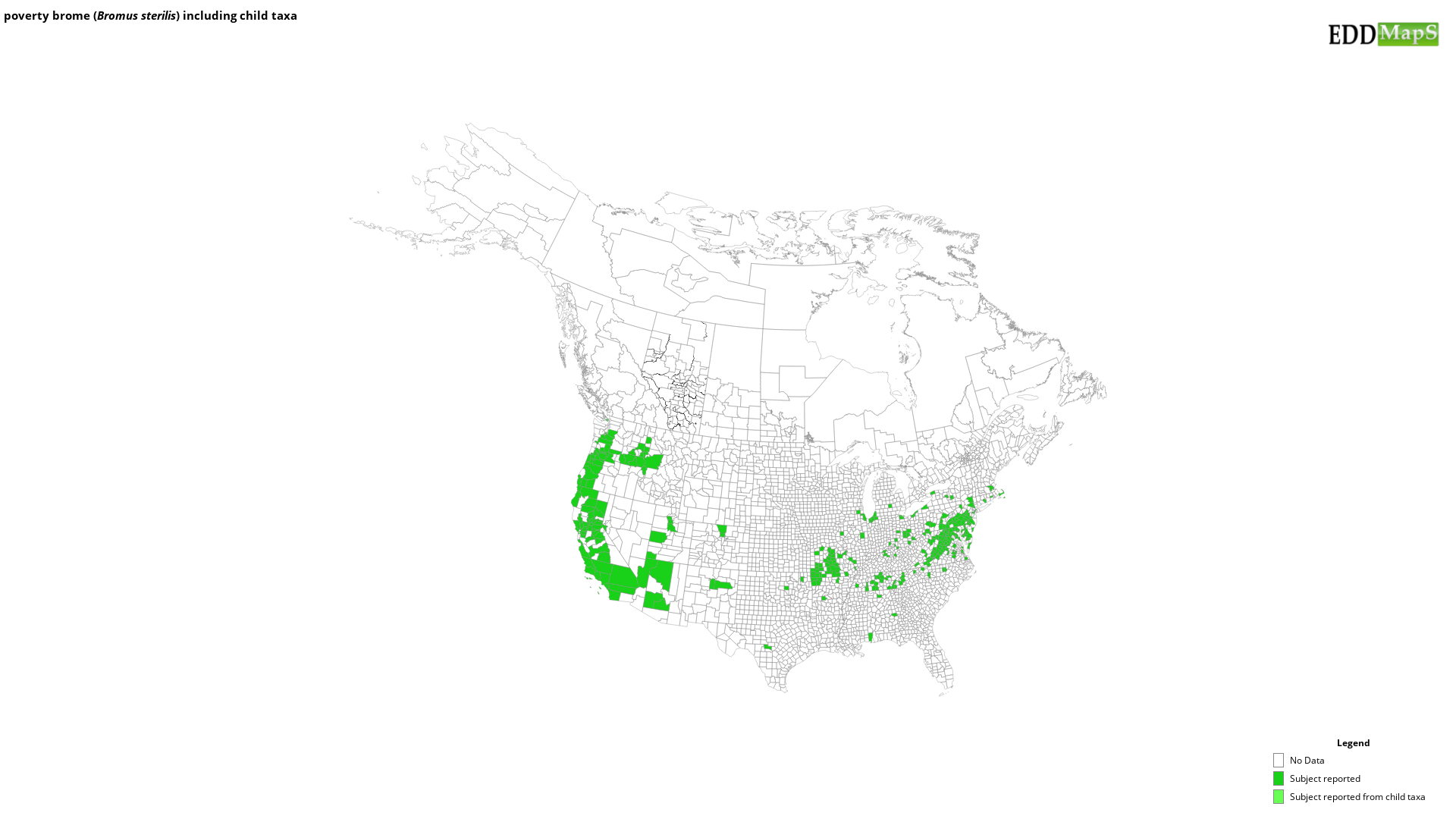poverty brome
(Bromus sterilis)
This species is Introduced in the United States
Origin
Native to Northern Africa, western and middle Asia, and Europe.
Appearance
Bromus sterilis is an annual grass, 12-32″ (30-80 cm) high. The stem (culms) are erect and smooth. Sometimes the culm can be rough at the very top.
Foliage
The leaves are from 0.08-0.16″ (2-4 mm) wide and they can be densely hairy. The leaf sheath is closed and hairy.
Flowers
The inflorescence is an open and branching panicle. The purplish to green panicle can be elongated and drooping. It flowers from March to June.
Fruit
Fruits are grains that are about 0.4″ (10 mm) long.
Ecological Threat
B. sterilis tends to inhabit disturbed areas such as wastelands and roadsides, but can also be a weed in agriculture fields. It can tolerate a wide range of soil types and moisture conditions.
http://swbiodiversity.org/seinet/taxa/index.php?taxon=1748
http://ucjeps.berkeley.edu/eflora/eflora_display.php?tid=16288
Native to Northern Africa, western and middle Asia, and Europe.
Appearance
Bromus sterilis is an annual grass, 12-32″ (30-80 cm) high. The stem (culms) are erect and smooth. Sometimes the culm can be rough at the very top.
Foliage
The leaves are from 0.08-0.16″ (2-4 mm) wide and they can be densely hairy. The leaf sheath is closed and hairy.
Flowers
The inflorescence is an open and branching panicle. The purplish to green panicle can be elongated and drooping. It flowers from March to June.
Fruit
Fruits are grains that are about 0.4″ (10 mm) long.
Ecological Threat
B. sterilis tends to inhabit disturbed areas such as wastelands and roadsides, but can also be a weed in agriculture fields. It can tolerate a wide range of soil types and moisture conditions.
http://swbiodiversity.org/seinet/taxa/index.php?taxon=1748
http://ucjeps.berkeley.edu/eflora/eflora_display.php?tid=16288
Selected Images
Maps
EDDMapS Distribution - This map is incomplete and is based only on current site and county level reports made by experts, herbaria, and literature. For more information, visit www.eddmaps.org
State Lists - This map identifies those states that have this species on their invasive species list or law.
Invasive Listing Sources
- Invasive Plant Species of West Virginia
- John Randall, The Nature Conservancy, Survey of TNC Preserves, 1995.
- National Park Service, Mid-Atlantic Exotic Plant Management Team Invasive Plant List
- Native Plant Society of Oregon, 2008
- Pennsylvania Department of Conservation and Natural Resources Invasive Plants
- WeedUS - Database of Plants Invading Natural Areas in the United States
- West Virginia Invasive Species Strategic Plan and Volunteer Guidelines 2014
- West Virginia Native Plant Society, Flora West Virginia Project, and West Virginia Curatorial Database System, September 3, 1999
Taxonomic Rank
| Domain: Eukarya |
| Kingdom: Plantae |
| Phylum: Magnoliophyta |
| Class: Magnoliopsida |
| Superorder: Lilianae |
| Order: Poales |
| Family: Poaceae |
| Subfamily: Pooideae |
| Tribe: Bromeae |
| Genus: Bromus |
| Bromus sterilis |
References
Common Name Reference: USDA, NRCS. 2010. The PLANTS Database. National Plant Data Center, Baton Rouge, LA, USA.
Scientific Name Reference: USDA, NRCS. 2010. The PLANTS Database. National Plant Data Center, Baton Rouge, LA, USA.


